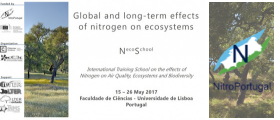
research areas
objectives
This line of research aims to investigate the adequate and effective ecological indicators to obtain the most efficient approaches and solutions. Better linking environmental, social and economic ecosystem services. And discovering the best ecological integration and long-term sustainability and change current procedures.
highlights
15 research papers
3 international networks
1 dissemination output

research projects & international networks

Green Surge - Green Infrastructure and Urban Biodiversity for Sustainable Urban Development and the Green Economy

Desert Warning - Modeling Ecosystem Structure and Functional Diversity as early-warning indicators of Desertification and Land-degradation
TeaComposition - Global Litter Decomposition Study +info
Environmental monitoring of dioxins, furans and metals in the vicinity of a hospital incinerator

iLTER - International Long Term Ecological Research Network +info

GISA - Integrated Management of Environment and Health in the Alentejo Litoral Region +info

Ecological Restoration of a Mediterranean Limestone Quarry - The case study at Outão (Serra da Arrábida, Portugal) +info
Almada - Monitoring studies of floristic and faunistic communities and environmental services assessment of Almada
eLTER H2020 project - Integrated European Long-Term Ecosystem & Socio-Ecological Research Infrastructure
Almada - Monitoring studies of floristic and faunistic communities and environmental services assessment of Almada
dissemination outputs

NecoSchool training videos | Find all the videos here
Book | Quarry Restoration & Biodiversity. FCUL and SECIL- Outão Cooperation
publications
Koch NM, Matos P, Branquinho C, Pinho P, Luchetac F, Martins SA, Vargas VMF. 2018. Selecting lichen functional traits as ecological indicators of the effects of the urban environment. Science of the Total Environment +info
Aguillaume, L., Avila, A., Pinho, P., Matos, P., Llop, E. & Branquinho, C. (2017) The critical levels of atmospheric ammonia in a Mediterranean holm-oak forest in North-Eastern Spain. Water Air and Soil Pollution, 228(3), 93. DOI:10.1007/s11270-017-3286-8 (IF2017 1.769; Q2 Environmental Sciences) +info
Dominguez-Morueco, N., Augusto, S., Trabal—n, L., Pocurull, E., Borrull, F., Schuhmacher, M., Domingo, J.L. & Nadal, M. (2017) Monitoring PAHs in the petrochemical area of Tarragona County, Spain: comparing passive air samplers with lichen transplants. Environmental Science & Pollution Research, 24(13), 11890-11900. DOI:10.1007/s11356-015-5612-2 (IF2017 2.800; Q1 Environmental Sciences) +info
Matos, P., Geiser, L., Hardman, A., Glavich, D., Pinho, P., Nunes, A., Soares, A.M.V.M. & Branquinho, C. (2017) Tracking global change using lichen diversity: towards a global-scale ecological indicator. Methods In Ecology and Evolution, 8(7), 788-798. DOI:10.1111/2041-210X.12712 (IF2017 6.363; Q1 Ecology) +info
Munzi, S., Cruz, C., Maia, R., Máguas, C., Prestello-Ramos, M.M. & Branquinho, C. (2017) Intra- and inter-specific variations in chitin in lichens along a N-deposition gradient. Environmental Science & Pollution Research, 24(36), 28065-28071. DOI:10.1007/s11356-017-0378-3 (IF2017 2.800; Q1 Environmental Sciences) +info
Ochoa-Huesoa, R., Munzi, S., Alonso, R., Arr—niz-Crespo, M., Avila, A., Bermejo, V., Bobbink, R., Branquinho, C., Concostrina-Zubiri, L., Cruz, C., Cruz de Carvalho, R., De Marco, A., Dias, T., Elustondo, D., Elvira, S., EstŽbanez, B., Fusaro, L., Gerosa, G., Izquieta-Rojano, S., Cascio, M., Marzuoli, R., Matos, P., Mereu, S., Merino, J., Morilla, L., Nunes, A., Paoletti, E., Paoli, L., Pinho P., Roger, I.B., Santos, A., Sicard, P., Stevens, C.J. & Theobald, M.R. (2017) Ecological impacts of atmospheric pollution and interactions with climate change in terrestrial ecosystems of the Mediterranean Basin: Current research and future directions. Environmental Pollution, 227, 194-206. DOI:10.1016/j.envpol.2017.04.062 (IF2017 4.358; Q1 Environmental Sciences) +info
Augusto, S., Pinho, P., Santos, A., Botelho, M.J., Palma-Oliveira, J. & Branquinho, C. (2016) Tracking the spatial fate of PCDD/F emissions from a cement plant by using lichens as environmental biomonitors. Environmental Science & Technology, 50(5), 2434Ð2441. DOI:10.1021/acs.est.5b04873 (IF2016 6,198; Q1 Environmental Sciences) +info
Hunter Jr., M., Westgate, M., Barton, P., Calhoun, A., Pierson, J., Tulloch, A., Beger, M., Branquinho, C., Caro, T., Gross, J., Heino, J., Lane, P., Longo, C., Martin, K., McDowell, W.H., Mellin, C., Salo, H. & Lindenmayer, D. (2016) Two roles for ecological surrogacy: indicator surrogates and management surrogates. Ecological Indicators, 63, 121-125. DOI:10.1016/j.ecolind.2015.11.049 (IF2016 3,898; Q1 Environmental Sciences) +info
Koch, N.M., Branquinho, C., Matos, P., Pinho, P., Lucheta, F., Martins, S.M.A. & Vargas, V.M.F. (2016) The application of lichens as ecological surrogates of air pollution in the subtropics: a case study in south Brazil. Environmental Science & Pollution Research, 23(20), 20819-20834. DOI:10.1007/s11356-016-7256-2 (IF2016 2,741; Q1 Environmental Sciences) +info
Pinho, P., Correia, O., Lecoq, M., Munzi, S., Vasconcelos, S., Gonalves, P., Rebelo, R., Antunes, C., Silva, P., Freitas, C., Lopes, N., Santos-Reis, M. & Branquinho, C. (2016) Evaluating green infrastructure in urban environments using a multi-taxa and functional diversity approach. Environmental Research, 147, 601-610. DOI:10.1016/j.envres.2015.12.025 (IF2016 3,835; Q1 Public, Environmental & Occupational Health) +info
Ribeiro, M.C., Pinho, P., Branquinho, C., Llop, E. & Pereira, M.J. (2016) Geostatistical uncertainty of assessing air quality using high-spatial-resolution lichen data: a health study in the urban area of Sines, Portugal. Science of the Total Environment, 562, 740-750. DOI:10.1016/j.scitotenv.2016.04.081 (IF2016 4,900; Q1 Environmental Sciences) +info
Augusto, S., Pinho, P., Santos, A., Botelho, M.J., Palma-Oliveira, J.M., Branquinho, C. (2015) Declining trends of PCDD/Fs in lichens over a decade in a Mediterranean area with multiple pollution sources. Science of the Total Environment, 508, 95-100. DOI:10.1016/j.scitotenv.2014.11.065 (IF2015 3,976; Q1 Environmental Sciences) +info
Barros, C., Pinho, P., Dur‹o, R., Augusto, S., Máguas, C., Pereira, M.J., Branquinho, C. (2015) Disentangling natural and anthropogenic sources of atmospheric sulfur in an industrial region using biomonitors. Environmental Science & Technology, 49, 2222Ð2229. DOI:10.1021/es505292t (IF2015 5,393; Q1 Environmental Sciences) +info
Lindenmayer, D., Pierson, J., Barton, P., Beger, M., Branquinho, C., Calhoun, A., Caro, T., Greig, H., Gross, J., Heino, J., Hunter, M., Lane, P., Longo, C., Martin, K., McDowell, W.H., Mellin, C., Salo, H., Tulloch, A. & Westgate, M. (2015) A new framework for selecting environmental surrogates. Science of the Total Environment, 538, 1029-1038. DOI:10.1016/j.scitotenv.2015.08.056 (IF2015 3,976; Q1 Environmental Sciences) +info
Listopad, C.M.C.S., Masters. R.E., Drake. J., Weishampe.l J., Branquinho, C. (2015) Structural diversity indices based on airborne LiDAR as ecological indicators for managing highly dynamic landscapes. Ecological Indicators, 57, 268Ð279. DOI:10.1016/j.ecolind.2015.04.017 (IF2015 3,190; Q1 Environmental Sciences) +info
Ramos A., Pereira M.J., Soares A., Rosario L., Matos P., Nunes A., Branquinho C., Pinho P. 2015. Seasonal patterns of Mediterranean evergreen woodlands (Montado) are explained by long-term precipitation. Agricultural and Forest Meteorology 202: 44–50 +info
eChanges - Ecology of Environmental Change, a research group from cE3c
© 2018 designed by paulis , developed by eChanges






